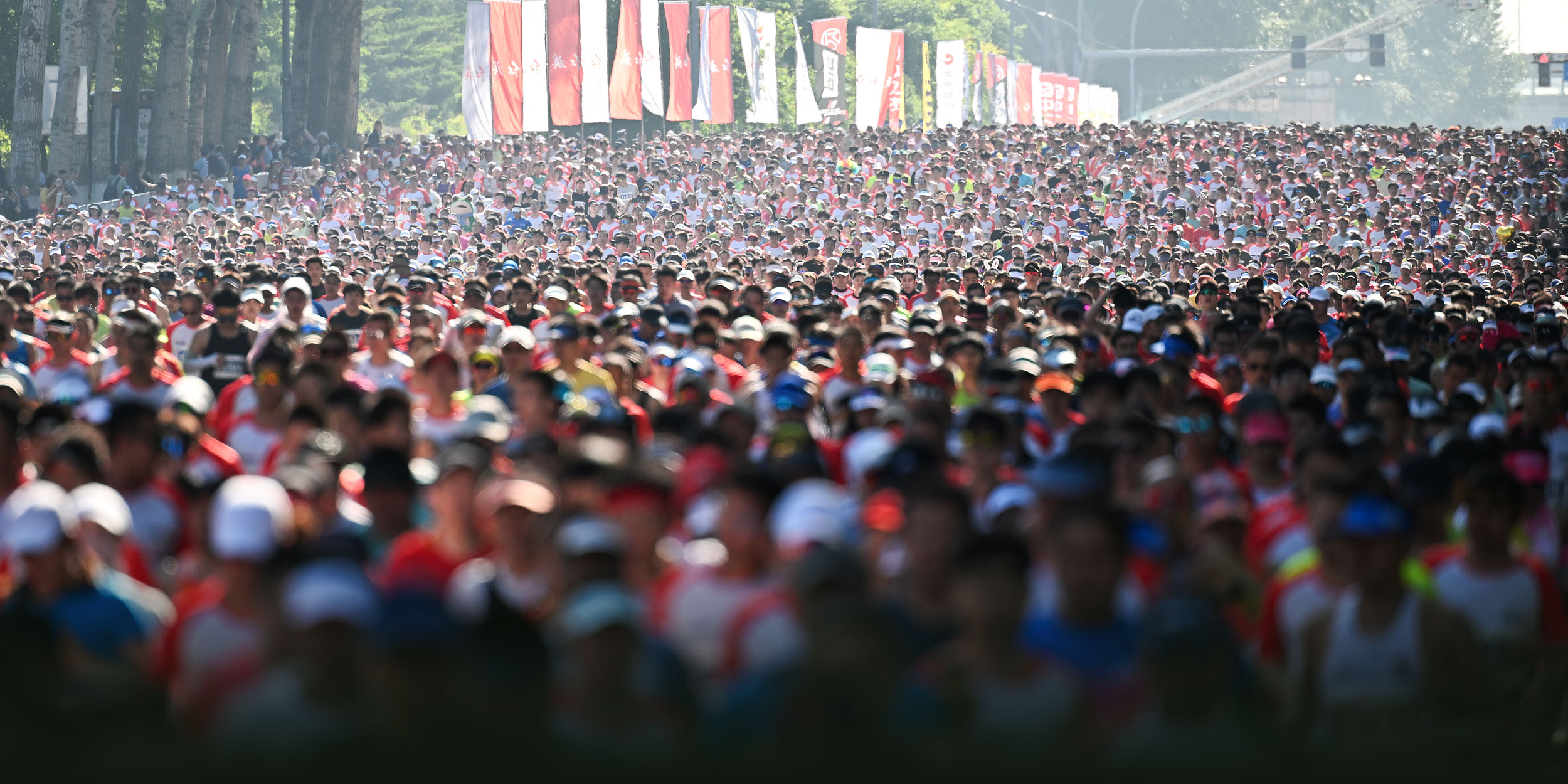
Crowd Control: Why China’s Marathon Boom Has Suddenly Hit the Brakes
After years of runaway expansion, China’s marathon calendar unraveled this autumn, with nearly 100 events canceled or scaled back, according to public notices and organizer statements.
The cancellations cover both major city marathons and smaller “fun runs,” marking the sharpest nationwide pullback in the sport since the pandemic. Officials and organizers say the pullback follows months of concern over weak race management and safety lapses. Rapid growth left many local events short on medical support and crowd control. Several races drew criticism for rule violations, including underage runners, unqualified pacers, and the use of unsuitable refreshments.
In response to the concerns, the Chinese Athletics Association (CAA) on Friday released new marathon regulations, stating that it will improve event organization systems, specify the responsibilities of parties involved, and strengthen risk prevention and safety assurance mechanisms to ensure safe, orderly, and high-quality marathons.
The new guidelines further specify the tightening of the approval process for running events, particularly C-class events — small-scale races organized by clubs and companies and supervised by local authorities — which must be certified by provincial sports administration departments via mandatory application procedures. In addition, applications for World Athletics-certified races should be submitted by the CAA to the international sports governing body. It also emphasized that fun runs and races aimed at the general public should be regulated and kept separate from full marathons frequented by experienced runners.
A day earlier, the CAA published its official list of approved marathon events for the rest of the year. The notice confirmed 116 races nationwide — all full or half marathons — signaling a push to standardize the calendar and exclude the shorter “fun run” formats that had drawn scrutiny.
The CAA said the listed events “only include full and half marathons,” with 73 offering both categories, 37 limited to half-marathons, and just six staging full marathons alone.
Liu Xiaolei, founder of Rapid Sport, a Beijing-based event company, said her team received a local authority notice in mid-October to cancel several upcoming races, including one in Dezhou in eastern China’s Shandong province, scheduled for the following weekend.
A four-mile run planned as one of the events accompanying a November marathon in the eastern Jiangxi province was also scrapped. “There was no formal explanation,” Liu said. “We just got the notice and had to stop everything immediately.”
The pace of China’s marathon industry has skyrocketed in recent years. In 2024, 749 road-running events were held nationwide, drawing about 7 million participants, compared to just 390,00 in 2022, according to the Chinese Athletics Association.
October to December typically mark peak months, accounting for almost 40% of the year’s races. By mid-October this season, 66 events had been canceled and another 37 postponed or scaled back, according to China Newsweek.
Organizers expect the tightening to accelerate as new rules take effect. Industry insiders say the shift could split the sport into two tracks: professional races for elite athletes and a shrinking space for the mass-participation runs that once defined China’s fitness boom.
“We hadn’t expected this,” said Liu. “But now that it’s here, we’re trying to respond objectively and think about how to upgrade our operations.”
Running wild
Much of the surge in China’s marathon participation over the past two years came from short-distance “fun runs” and “health runs,” typically under five kilometers and open to casual participants.
These events drew almost half of all runners nationwide, insiders estimate. And they turned city streets into weekend festivals, but they also exposed the sport’s weakest links: inconsistent safety checks, limited medical planning, and thin oversight.
They are now among the first to be cut.
Last week, organizers of the 2025 Shanghai Marathon announced the cancellation of its five-kilometer fitness run and all charity quotas, which had been set to include 15,000 of the race’s 38,000 participants, citing event adjustments. The race, scheduled for Nov. 30, will now proceed only with its full-marathon runners.
Veteran runner Liu, 35, had convinced his partner — a newcomer to the sport — to join a local five-mile “Happy Run” in Zhengzhou, capital of the central Henan province. Two weeks before the race, it was canceled without explanation. “A bit of a pity,” he said, asking to be identified only by his surname citing privacy concerns. “But there’s nothing we can do.”
A former hypertension patient, Liu said distance running transformed his health over the past three years. He has completed five races this year, mostly half-marathons, and has watched crowds grow more chaotic as participation swelled.
“Many people join not because they love running, but because they enjoy the atmosphere — the eating, drinking, even cosplay,” he said.
Event organizers told Sixth Tone that such scenes, amplified by viral complaints and safety incidents such as heatstroke and falls amidst large crowds, have fueled growing skepticism toward marathons. Combined with local budget pressures and concerns about managing large crowds, they say the backlash has pushed officials to halt events even before new rules take effect.
Some organizers were trying to keep marathons inclusive by offering local twists. Last August, the Harbin Marathon went viral for its liushui xi or “banquet-style” refreshment stations serving dumplings, sausages, barbecue, and ice cream to runners.
Runner Liu recalled seeing online complaints about events that only offered bananas to participants. “Some even mocked it, asking if the city’s local specialty was bananas,” he said, laughing. “The comments are ridiculous to me — bananas are great for replenishing energy quickly.”
He also noted that many casual runners, unfamiliar with marathon rules or etiquette, sometimes disrupt events, cutting across lanes or ignoring designated areas.
Negative comments about organizers are common too, though not always fair. “Some amateur participants praise races that provide abundant food and drink stations, assuming that makes the event better,” said Liu. “But for full or half marathons, excessive food can be unsuitable for professional athletes and may even pose safety risks.”
Complaints have also centered on fairness — from foreign athletes dominating prize pools to low lottery odds and opaque entry systems — feeding a perception that marathons are becoming both overregulated and inaccessible. The Friday announcement emphasized improving the fairness of the marathon lottery system, mandating that at least 90% of the spots in each event should be open to the general public.
“People have gradually realized that marathons — once seen as something positive — have shifted to become something overwhelmingly negative,” said Liu, who admitted he has become reluctant to read online discussions about the events he joins. “It’s hard to find positive feedback after a race; most of what you see online now is complaints.”
Liu Xiaolei, the organizer, concurs. “Public sentiment around marathons has really worsened in recent years,” she said. “For the industry, that has a lot of negative consequences.”
Course correction
For race organizers, the cancellations have laid bare the financial risks of China’s marathon boom.
Most autumn events were already deep into preparation when the notices arrived. “Once canceled, all the early investments — manpower, materials, finances — are lost,” said Rapid Sport’s Liu Xiaolei. “If we can just cover our costs, that’s already the best outcome.”
According to the General Administration of Sport, a large city race can generate 600 million to 700 million yuan ($85 million to $100 million) in economic activity. Nationwide, 10 international “Gold Label” or higher marathons in 2024 generated a total of 5.43 billion yuan.
For many local authorities, marathons were also city branding projects. “Marathons naturally integrate urban resources, expand city spaces, and showcase city images,” Bai Yufei, a professor at Beijing Sport University, told domestic media.
But the push to boost local consumption through marathons has not always paid off, especially in smaller cities that rely heavily on government funding.
According to Si Shujian, general manager of sport event management company Zhongji Sports in Beijing, costs typically range from 25 million to 30 million yuan in provincial capitals, 12 million to 15 million in prefecture-level cities, and 7 million to 9 million in county areas.
Despite the high costs, more small cities have been vying to host higher-profile events. Media reports last year showed that among 46 top-tier “A-class” races held between March and April, 17 were organized by third- and fourth-tier or county-level cities, accounting for 37% of the total.
Hosting races that meet World Athletics certification standards adds further expenses — inviting elite international athletes, compliance audits, and a minimum fee of 167,000 yuan, along with larger prize pools.
As costs climbed and local budgets tightened, the Chinese Athletics Association stepped in, introducing new measures to bring the sport under closer supervision.
In early 2024, it barred certified organizers from hosting two sanctioned races within 14 days. This past July, it ordered stricter risk assessments, accountability, and local supervision. And in August, the National Health Commission said that marathon is an extreme sport, suitable only for a small number of well-trained individuals, and advised that marathons “should not be promoted as a mass-participation sport, but as a hobby for a smaller group.”
In recent weeks, several races have also canceled invitations to foreign elite runners, fueling speculation that broader limits may follow. Rumors of a “marathon regulation” — said to include caps on prize money, bans on shorter fun runs, and restrictions on foreign athletes — spread quickly online prior to the CAA’s Friday announcement.
Across social media platforms, runners and spectators alike acknowledge problems in race management but lament the abrupt wave of cancellations. Some see the new oversight as necessary for safety; others argue it risks stifling the community that helped the sport grow.
Liu from Rapid Sport admits the uncertainty has made planning difficult for next year’s World Athletics-certified events. “We hope clear guidelines can be released soon,” she said. “It would help us plan our work more effectively by the end of the year.”
That uncertainty has also rippled through the running community. Veteran runner Liu said he supports tightening regulations “but not such a simplistic, one-size-fits-all approach,” adding that major cities should still pursue international certification to raise their global profile and improve domestic athletes’ performance.
Others worry the push for order could sideline the mass participation that made marathons popular in the first place. Fang, an amateur runner for three years with six marathon finishes, said smaller “happy runs” are where many newcomers discover the sport.
“I see so many people who just want to experience the atmosphere and run on the roads where they grew up — maybe starting with five or 10 kilometers, gradually falling in love with the sport,” he said. “That’s meaningful.”
“I think we don’t need to overcorrect,” Fang added. “The industry can be regulated better through standards, not blanket restrictions.”
Runner Liu believes marathons should remain something positive, “a way to encourage people to explore their potential, deepen their understanding of sport, and improve their health.” He said both organizers and participants share responsibility for how things turned out. “Together, we’ve made the environment worse.”
Looking ahead, Liu from Rapid Sport said her company plans to separate professional marathons from general fun runs.
“Given the scale of events and participants now, maybe the sport is mature enough for this kind of differentiation,” she said, adding that professional and amateur marathons will soon cater to different groups.
“I believe the professional standards of Chinese marathons, as well as public enthusiasm, will continue to rise. It’s time to focus on quality, not just quantity.”
Contributions: Marianne Gunnarsson; editor: Apurva.
(Header image: Runners compete during the 2025 Hongqi Changchun Marathon in Changchun, Jilin Province, May 25, 2025. VCG)










